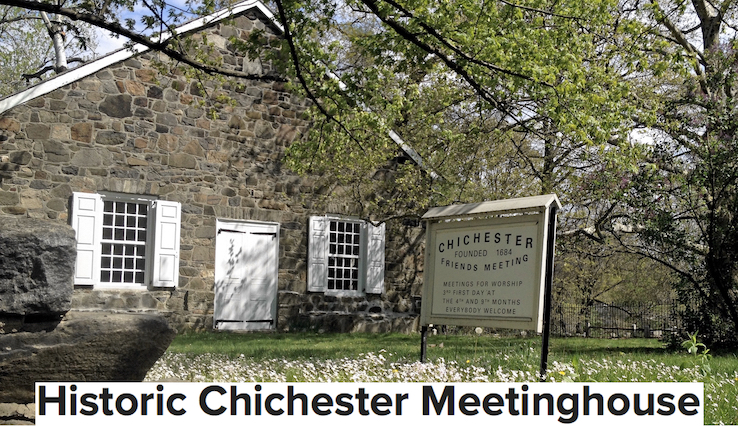On October 28, 1682, William Penn, along with another 100 Quakers of fortitude, sailing in the ship Welcome docked in Upland(now known as Chester), then the northernmost port on the west side of the Delaware River in the Colony of Pennsylvania. A few Quakers, who had settled there as early as 1675 in the midst of several hundred Swedes, Dutch and Finns strung out along the Delaware River, greeted Penn and his fellow travelers. Most of the Friends who greeted or accompanied Penn had experienced religious persecution in England and Wales. In fact, historians estimate that about 15,000 Quakers were imprisoned in England between 1661 and 1685, with up to 1,400 in English jails in 1685. Even for those steeled to persecution, emigration to the New World was not for the faint of heart.
The multi-week long trip across the Atlantic Ocean was perilous because of the threat of storms and disease. (One-third of the Welcome’s passengers died of small pox.) Those intrepid Quakers who survived the trip entered an area that was primarily a virgin forest without roads or bridges. In 1682 they arrived just before the onset of winter. Thus, the Quakers who accompanied Penn did not have time to clear land, build homes, plant crops and harvest those crops in time to provide food during the winter months. To survive, many of them dug “pits” or “caves” to live in. Among them was Caleb Pusey, one of Penn’s partners in a grist and saw mill business that began operations in 1683 on Chester Creek just north of Chester.
The Quakers settling in Chester County (which at that time included what is now Delaware County) were not deterred. They lived their lives with religious zeal, having held their first monthly meeting in Upland in September 1682, a month before Penn’s arrival. As Samuel McPherson Janney explained, “The Friends, soon after their arrival, were careful to establish, in every neighborhood, meetings for divine worship, where they offered up grateful thanks to the Father of Spirits for the many blessings they enjoyed.” Religious Society of Friends from its Rise to the Year 1828.
Their religious zeal was rooted in George Fox’s revelation that Christ was a “voice” that existed in every human. These Quaker zealots initiated and nurtured cultural patterns in the new world that had far reaching effects, even as far as the constitutional underpinnings of the future state. Spurred on by the genius of William Penn, this community interacted with the indigenous people with respect and contract, established land grants that were small and numerous, produced schools that were open to non-Friends, instituted governing bodies which were responsive to the governed, and readily accepted immigrants from other countries. Yes, they had their faults including accepting slavery far too long and becoming enticed by material wealth, but in comparison to other English migrations to the north and the south, the Delaware Valley Friends brought a morally democratic (with a small “d”) framework into their Pennsylvania and West Jersey communities.
By the end of 1683 the Quaker settlements in Chester County were anchored at four points: Chester, Chichester, Darby and Haverford. “From these points the new settlements rapidly developed and spread over the adjacent townships.” Except for Haverford, the Quaker immigrants “sat themselves down in the midst, or the vicinity, of a civilized people.” But the Welsh Quakers settling around Haverford were “forced, at once, to plunge into the wilderness” while they spread to Radnor, Newtown, Goshen, Tredyffrin and Uwchlan” townships.
By March 1684 there were enough Quakers in and around Chichester for a monthly meeting to be established there. Two years later, Quakers held monthly meetings in Quaker homes located in Concord, Bethel and Birmingham townships. That same year they built a meetinghouse in Chichester.
Quakers were expected to go to meeting for worship two times a week and to travel up to 10 miles to and from each meeting. Doing so was no mean feat given the absence of improved roads (or in some cases any roads) and bridges over streams and creeks. Wolves abounded in the woods. Their large numbers correlated to the increase in the number of livestock foraging in the forests. Fortunately, the Native Americans, with whom Penn had established an amicable relationship, were not a danger even though on at least one occasion rumors circulated that they were massing to attack. As it turned out, 500 were camping peacefully along the Brandywine Creek.
In 1684 the witch hysteria reached Chester County. Several women living “at the mouth of Crum Creek” were accused of being witches. They were tried before William Penn and his Council. What was the outcome?
If you come to Quarterly Meeting on July 24, 2016, you can hear Quaker historian Nancy Webster tell you all about that trial as well as describe the life and times of Quakers in Chester County in the late 17th century. Nancy will begin her talk while we are eating lunch at Concord Monthly Meeting, and then she will continue her talk at Chichester Meetinghouse in Chichester Township and then at the Caleb Pusey house in Upland Township. Nancy and we look forward to seeing you there.
Charles Spadoni and Rich Ailes from the July 2016 Concord Quarter Newsletter
